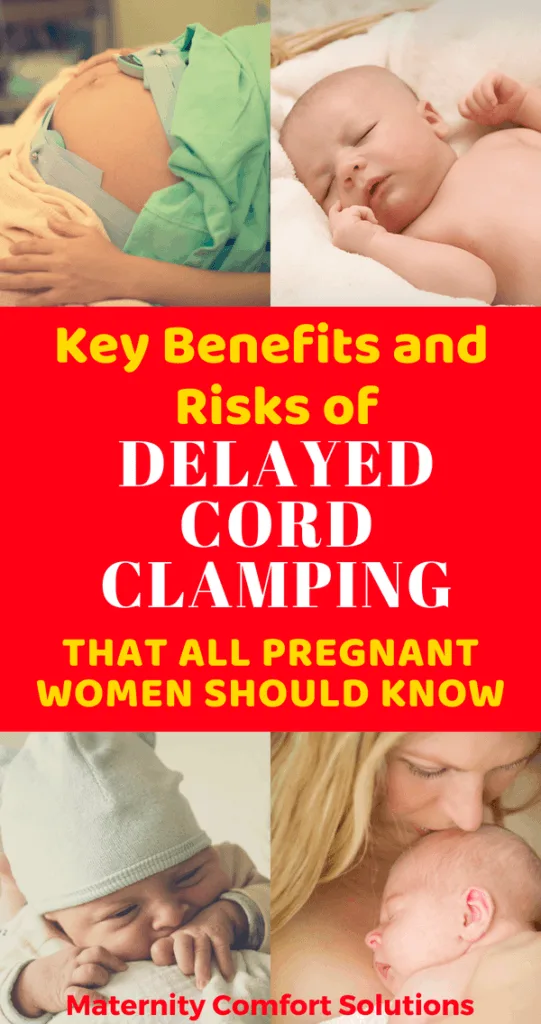
Delayed cord clamping has recently been a popular topic in pregnancy books and among various pregnancy forums.
As a result, you have likely been told to include this procedure in your birth plan.
You may wonder what exactly is delayed cord clamping? Is delayed cord clamping beneficial to my baby? Are there any risks with delayed cord clamping? These are common questions and concerns of moms to be!

This post contains affiliate links. You can read our affiliate disclaimer at the bottom of this post.
Delayed cord clamping has only become popular in the past few years. Up until recently, it was standard practice to cut the cord early, as it was believed this would lower the mother’s risk of postpartum hemorrhage.
Research has shown that to not be the case, but early cord clamping has still been standard practice.
Even today there are providers who are reluctant to delay cord clamping, so be sure to discuss the practice and your desires with your doctor before your delivery.
Let’s take a look at the benefits and potential risks of delayed cord clamping so you will have the information you need to make the best decision about whether or not this procedure is right for you and your newborn.
What Is Delayed Cord Clamping?
Delayed cord clamping is a relatively new development in the field of obstetrics.
Delayed cord clamping is when the baby’s umbilical cord is left unclamped for one minute to two minutes to allow the blood from the cord and placenta to travel back into the baby.
This article is intended to present a balanced view of the pros and cons associated with this procedure.
Most important to keep in mind is that this procedure is performed as long as the delay does not compromise the health of the mother or baby.
Update 09/13/2020: There have been no recommended changes in the practice of delayed cord clamping during the COVID-19 Pandemic from ACOG. But you should still discuss it with your provider as some physicians, midwives and hospitals may have different protocols in place.
[wps_icon icon=”check” background=”#31b522″ color=”#ffffff” size=”18″ padding=”6″ radius=”0″]Update for 2020: COVID-19 and Pregnancy
COVID-19 is an illness caused by the novel coronavirus SARS-CoV-2. You’ll want to ask your doctor any questions you have about COVID-19 and your specific risk factors at your next visit.
For the very latest on COVID-19 and pregnancy, you should visit the CDC at the link below:
[wps_alert type=”note”]
Coronavirus Disease 2019 (COVID-19)
Based on what we know at this time, pregnant people might be at an increased risk for severe illness from COVID-19 compared to non-pregnant people. Additionally, there may be an increased risk of adverse pregnancy outcomes, such as preterm birth, among pregnant people with COVID-19.
[/wps_alert]
What are the benefits of delayed cord clamping?
- After delivery, the umbilical cord still is pulsating and perfusing blood under pressure. Delayed clamping of the cord does allow more blood to enter the newborn’s bloodstream. For a newborn that is otherwise going to be anemic, this can be beneficial.
- For full-term babies, there are three benefits that have been identified:
- A smoother transition away from fetal circulation. This allows for improved circulation to the major organs.
- Transfer of more stem cells to the baby. Stem cells play a key told in the immune system.
- Can result in a 30% increase in blood volume since one-third of fetal blood volume resides in the placenta.
- There is evidence that delayed cord clamping can lead to a decrease in the incidence of intracranial hemorrhage and necrotizing enterocolitis in preterm babies.
- May offer neurodevelopmental benefits. Delayed cord clamping may improve fine motor and social skills later in life. A study in JAMA Pediatrics found that leaving the cord attached for a few minutes provided a boost in neurodevelopment years later.
What are the potential negatives of delayed cord clamping?
- Delayed neonatal resuscitation:
Should there be a need for immediate neonatal intervention for an anticipated congenital problem or to clear out a non-vigorous, newborn with meconium, immediate intervention by a neonatal team would be delayed.
- Hypertransfusion can lead to neonatal jaundice which may require phototherapy.
The incidence of neonatal jaundice after delayed cord clamping is small; however, your healthcare team should be prepared to monitor for jaundice and be prepared to treat neonatal jaundice if necessary.
- Delayed skin-to-skin contact.
Most moms desire skin-to-skin contact immediately after delivery to promote bonding.
Based on a study designed to evaluate the amount of blood delivered to the infant if held above or below the perineum, there was no significant difference.
Thus, it is ok to ask your doctor or nurse to place the newborn on your lower abdomen during delayed cord clamping.
Maternity Hospital Tour: 20 Critical Questions To Ask
A question that is very often asked by pregnant women is “Is it necessary to take a hospital tour before my delivery?” Yes! Why should you take a maternity hospital tour? Simple, you want to know what to expect when you are in labor.
- Interferes with blood collection for cord blood banking.
The process of collecting cord blood must be done immediately after delivery.
The blood is collected using sterile technique and the amount of blood collected, even after ICC (Immediate Cord Clamping) is limited.
After (DCC) delayed cord clamping, there is no blood remaining for collection.
Important Information About Fetal-Placental Circulation
The topic of cord clamping would not be complete without a short explanation about placental function (when it begins and ends) and fetal-placental circulation physiology.
The placenta delivers oxygen to the fetus throughout the pregnancy by transferring oxygen from the maternal circulation to the fetal circulation.
The fetal circulation never mixes with or comes in direct contact with the maternal circulation.
The fetal-placental circulation transfers oxygen and other nutrients from the mother to the baby.
During the 3rd stage of labor, the placenta separates from the uterus (womb) and no longer delivers oxygen to your baby.
This is why placental abruption is an emergency situation.
When your baby enters the world and takes his or her’s first breath, the ductus arteriosus (responsible for shunting fetal blood to the placenta during pregnancy) closes, and blood is channeled to the baby’s lungs for oxygenation.
The placenta does not provide oxygen after it is delivered.
Birth Plans and Delayed Cord Clamping
If you are interested in doing delayed cord clamping after delivery, you should include that in your birth plan.
You can read about creating a stress-free birth plan here: 7 Simple Steps To A Stress-Free Birth Plan
7 Simple Steps To A Stress-Free Birth Plan
A birth plan is a document that lets your health care providers know your preferences for the birth of your baby. Planning for your labor and delivery can feel overwhelming with so many decisions to be made. Don’t worry. Creating a stress-free birth plan is possible! This post contains affiliate links.
Even though delayed cord clamping is now the norm, you should discuss it with your doctor to be sure you are both clear on your wishes.
Be flexible if delayed cord clamping was not able to be done due to an emergent situation. Your providers always want your birth plan to go the way you want.
We recommend that you keep your birth plan limited to one page. Include the things that are most important to you.
Other articles you may find helpful:
REFERENCES
ACOG COMMITTEE OPINION ON DELAYED CORD CLAMPING


